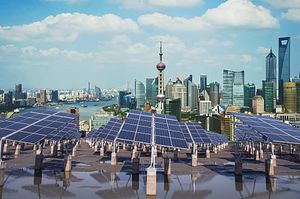The United States and China recently agreed to reduce carbon emissions in what has been called a landmark climate change agreement. This agreement followed months of negotiation. While the U.S. agreed to reduce carbon emissions by 26-28 percent of 2005 levels by 2025, China agreed to draw 20 percent of its energy consumption from alternative fuels and peak its carbon emissions by 2030. For China, the effort is plausible and may do more than analysts believe – indeed, it can be viewed as a good start toward reducing carbon emissions and promoting renewable energy.
Often, the view of China’s environmental regime is negative. This is not only because China’s environment is severely polluted, but also because its track record on reducing carbon emissions is mixed. China has in the past set targets for the renewable energy composition of all energy sources. China’s Renewable Energy Law of 2007 aimed to quadruple GDP while only doubling electricity consumption by 2020. China also set a goal in the Eleventh Five Year Plan to reduce the energy intensity of GDP by 20 percent by 2010, implying a 2.8 percent annual growth rate in energy use. So far, these goals have not been met.
On the other side of the coin, China’s leadership is well aware that the role of its carbon emissions in climate change is problematic. Premier Li Keqiang declared a “war on pollution” in March 2014. Dan Rosen, in a report written for the Asia Society in October, points out that China has already made progress by destroying some highly polluting plants, negotiating requirements for particulate matter reduction, installing pollution controls on coal-fired plants, and revising the Environmental Protection Law (EPL) to allow for public interest lawsuits, among other moves. Rosen asserts that emissions reduction at the firm level will depend on enforcement of emissions laws, and that a litmus test for emissions law enforcement will lie in the number of public environmental interest lawsuits accepted by courts beginning January 1, 2015, when the revised EPL is put into effect. China therefore appears to be moving in the right direction using a number of different tactics.
Meanwhile, China has driven down the costs of renewable energy, particularly in the production of solar cells. China has also been investing heavily in its renewable energy supply structure, and currently has the largest renewable energy capacity in the world. The State Grid Corporation of China is working to integrate wind and solar-photovoltaic generation and storage devices into the main grid, and other efforts promise continuing strides in renewable capacity expansion.
Some analysts’ responses to this climate agreement have not focused on China’s renewable energy pledge, and therefore have been quite negative, stating that China has an easy task since it has until 2030 to peak on emissions. This goal may be less stringent than the policy implemented in the U.S., but certainly the other half of the promise to increase renewable energy sources to 20 percent of energy consumption will pose a sufficient challenge. It is also worth keeping in mind that this agreement was not meant to represent a ceiling on climate change policies but rather a floor. As John Kerry wrote in his November 12 New York Times op-ed that “there is no question that all of us will need to do more to push toward the de-carbonization of the global economy. But in climate diplomacy …you have to start at the beginning, and this breakthrough marks a fresh beginning.”
Certainly, the collaboration on research and execution described in the U.S.-China agreement will help improve the climate change outlook. The agreement expands the commitment to the U.S.-China Clean Energy Research Center, advances carbon capture, facilitates collaboration on phasing out hydrocarbons, establishes a low-carbon cities initiative, promotes trade in green technology goods, and initiates pilot programs in green energy use. These efforts move both nations in the right direction and represent clear strides toward intervening in the progression of climate change. China surely is making concerted attempts to secure our shared global future.

































